Ira Baker LIRR Station Agent:
A Railroad Biography
by Dave Keller with assistance from Arlene Girvin
Although the LIRR extended
itís south shore division from Bridgehampton to Montauk in 1895, with
passenger stops at East Hampton and Amagansett and fishing stops at
Promised Land, Fanny Bartlett and Napeague Beach, very few trains ran
further east than Amagansett.
Amagansett became a terminal
for trains and, as a terminal town, had all the typical structures that
identified itself as a terminal, such as a depot building, a small engine
house, a wye for turning locomotives, watering and coaling facilities and . . . . rooming
houses at which the crews stayed after
ending their daily runs at
this terminal.
Between the 1895 opening of the
line and June, 1929 when Summer employee timetable #110 went into effect
officially ending Amagansettís function as a terminal, this railroad
town saw a lot of railroading and dealt with a lot of railroad men.
However, as more and more runs were extended to Montauk the role of
Amagansett as a terminal grew less and less so that by October, 1928, the
only run that terminated at Amagansett was the Greenport Scoot.
Effective, June, 1929, the Greenport Scoot terminated at Speonk,
many station stops west of Amagansett. (Data
courtesy of Art Huneke at Arrts-Arrchives.com)
It was reported to me by a now long-deceased LIRR veteran that one of the boarding houses, specifically,
would not only put railroad men up for the night on a daily or weekly
basis, and provide them dinner but the woman who ran the house would make
lunches for the men to bring with them to work!
One of these LIRR veterans who
came to Amagansett during itís days as an active terminal was Ira Baker.
Ira, born in 1882 in
Fredericksburg, VA, worked different jobs, including several other
railroads as well as non-railroad positions before coming to work for the
LIRR.
He first worked for the LIRR
beginning in 1901 then left . . .
and returned in 1903. . .then left, and returned for good in 1909.
He was first at the Cedarhurst
station beginning there on March 1, 1909 and then at Glen Head on the west
end of the island. He then
became agent at the terminal facilities at Amagansett . . . quite a
distance from that part of the island where he first started.
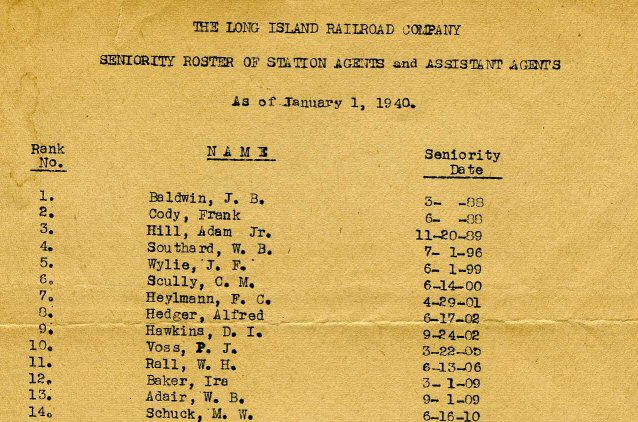
This
is a scan of a LIRR seniority roster for agents and assistant agents
issued on January 1, 1940. Ira
Baker had been an agent since 1909. 31
years later he's still only #12 on the roster with old timers ahead of him
with seniority dates as far back as 1888!!!!
The way people held jobs back then it was nearly impossible to
climb the seniority roster more than a few positions in your own career.
(Courtesy of George G. Ayling, Dave Keller archive)
Ira came to Amagansett sometime in 1909-1910 and worked the original depot building that was constructed with the lineís extension to Montauk in 1895.
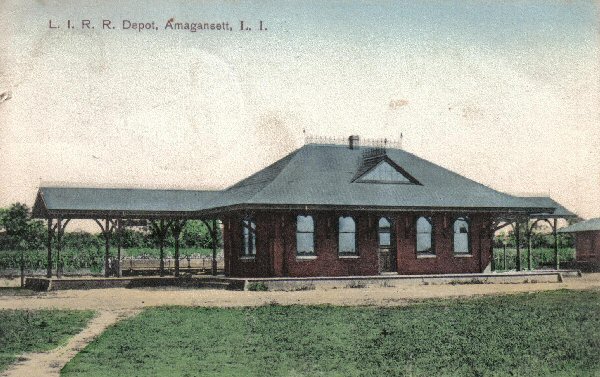
c.
1909
postcard view but a rare one nonetheless as the number of images of the
original Amagansett station are scarcer than hens' teeth!
Note the fancy wrought-iron roof tree atop the ridge of the depot.
Also note the old brick freight house to the far right which still
stands at the time of this biography. Compare this image with the very
last image posted in this biography, taken in 1970. (Courtesy of Art
Huneke at Arrts-Arrchives.com)
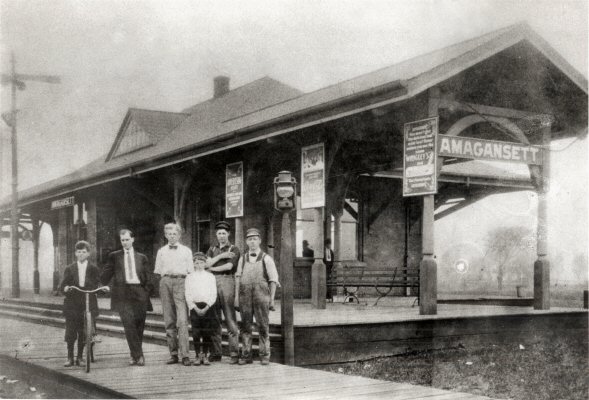
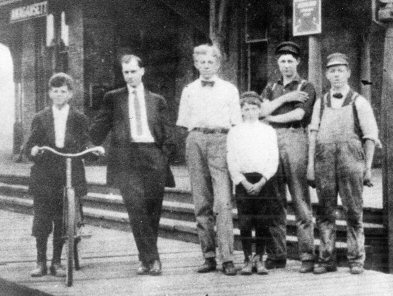
A VERY rare photographic view of the original Amagansett depot, with Ira Baker (in suit) along with assistants. c. 1909-1910. (Courtesy of Art Huneke at Arrts-Arrchives.com)
This depot was a one-level
structure with no living accommodations so Ira did as all the other
railroad men did . . . . he boarded at a local rooming house of which
there were several. He picked
one run by Elizabeth Vaughn.
It was at this specific
boarding house that Ira met Elizabeth's daughter Anne who was 10 years
younger than him Ira and Anne
began seeing each other and were married in 1910.

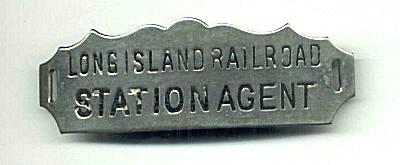
He was away for a short time working the station at Quogue when on August 15, 1910, the relief agent who was on duty "let the station burn down" according to Ira. Knowing that a replacement building was to be erected, he requested of the railroad that living quarters be part of the structure. They agreed and the result was a beautiful, two-storey depot structure built in the Dutch Colonial style with gambrel roof and quarters upstairs for the agent and his family.
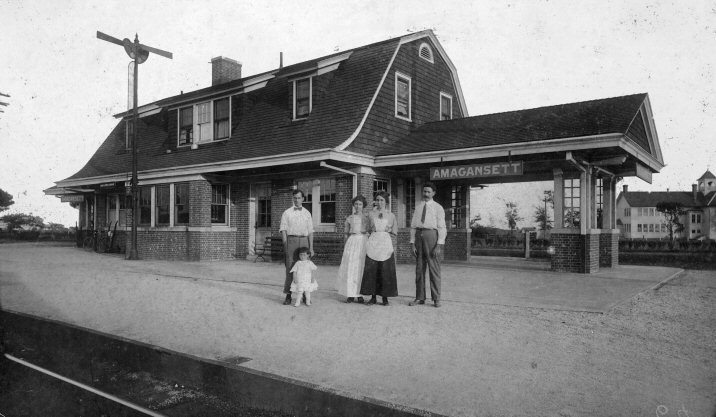
.jpg)
The above image depicts the new Amagansett station c. 1912-13 with living
quarters upstairs for the agent and his family.
Ira Baker is at the left with his daughter. His wife, Anne, is to
the right, next to an unidentified woman who may be the wife of the
unidentified man at the right. It
would appear from the shirt and tie that he may have been Ira's assisting
ticket clerk. (Image courtesy of Ira Baker's granddaughter, Arlene Girvin,
Dave Keller archive. Many
thanks to the Photoshopping ability of Steve Lynch for his outstanding
restoration of a badly marked and very aged, but wonderful print!
Amagansett grew on Ira along
with his ties to the friendly community and the couple raised their
children there and remained there for all of Iraís long career with the
LIRR. As a pastime he and his
wife took frequent, long walks along the sandy beach walking miles at a
time.
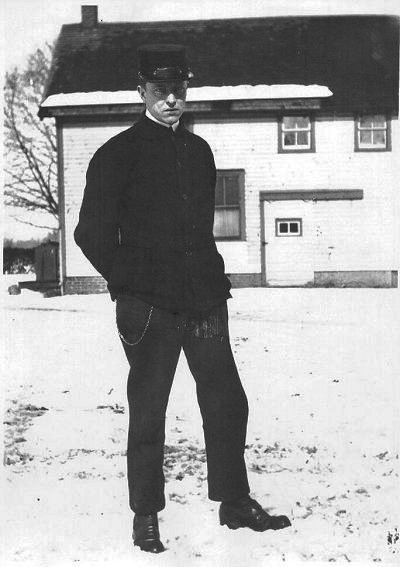
(Image courtesy of George G. Ayling, Dave Keller archive)
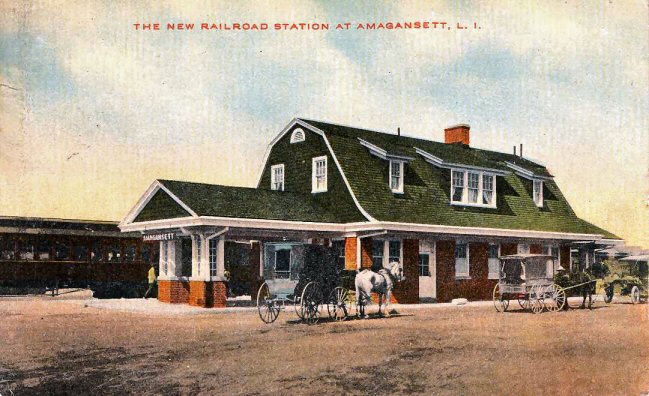
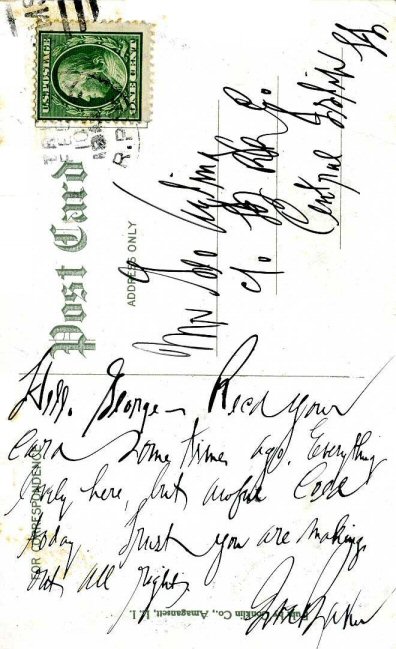
The
postal cancellation on this card is hard to read but is an R.P.O. (Railway
Post Office) cancellation which means this card was carried and postmarked
aboard a moving LIRR train. The
date may be 1912 or 13. The
fact that the image on the card is captioned "The New Railroad
Station at Amagansett" means Ira had some of these cards in his desk
since the 1910 opening. (Courtesy of George G. Ayling, Dave Keller
archive)
Below is an example for a Form 19
train order, issued by the Superintendent's office at Jamaica station (Dave
Keller archive):
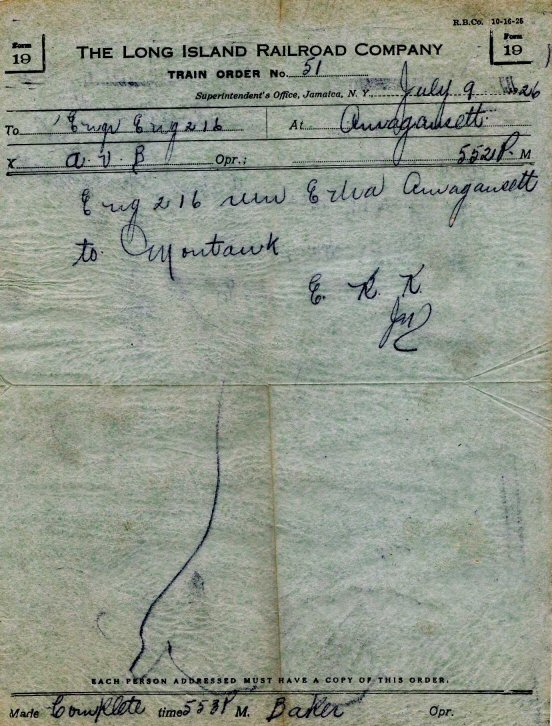
Whatís unusual about this
train order?
Well, for a start, compare the
signature and handwriting of this order from July 9, 1926 with that of the
postcard sent to George Ayling posted above.
The postcard is in Iraís handwriting.
This train order is not, yet it's signed (made complete) by an
operator named Baker.
Also . . . at the top of the
order are the initials of the operator who copied the order.
These initials are ďA. V. B. ď not ďI. B.Ē
It would appear that when the
dispatcher called for the operator at Amagansett to copy this train order
on July 9th of 1926, Ira was somehow indisposed and his wife Anne not only
copied the order, but read it back to the dispatcher and then made it
complete, signing HER name in HER handwriting and adding HER initials at
the top.
A MOST unusual occurrence I
would think. At age 19 and not
an employee of the LIRR at the time, I once copied a train order from the
dispatcher at Jamaica for the operator at PD tower who was indisposed when
the call came in and read it back to said dispatcher but the order was
signed by the operator when he came back to his desk.
I did not sign MY name to it.
Now. . ..itís possible that
she may have also been employed by the LIRR and was well within her rights
to copy this order, but was probably not and was just covering for her
husband. It also meant that
she could read American Morse Code as well, as telegraph was still a major
means of railroad communication in 1926.
She certainly knew how to fill out and copy a form 19!!!!!
I wonder how many other times this was done . . . not only here but
at other stations where the agentís family resided.
This train order is a rare find, indeed, as it displays an event of
an era long-passed. Unfortunately
I do not have any train orders in my archive copied and signed by Ira
himself.
The train order below is a Form 31 order
which required the conductor and engineer of the train to physically come
into the train order office and sign for the order on the order form and
take the order with them:
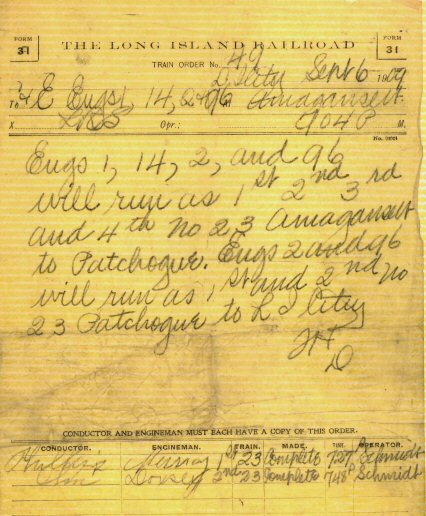
While
not signed by Ira Baker, this Form 31 train order was issued at Amagansett
on September 6, 1909 and was copied and made complete by block operator
Schmidt who was the 2nd trick (or shift) operator at the time, seeing this
order was made complete at 7:04 pm. The
1st trick operator who would have been Ira or one of his assistants,
usually worked the hours of 6:30 am to about 3:30 pm.
(Dave Keller archive)
They were caught.
Ira had found their buried clothing and, figuring it to be
discarded trash, intended to burn it, but had second thoughts that it may
have belonged to someone who would be back for it, so he never got around
to it and after the arrests, he turned the clothing into the authorities
and it was sent to Washington, DC for investigation.
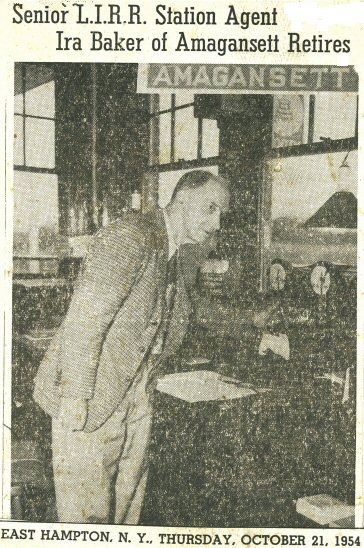
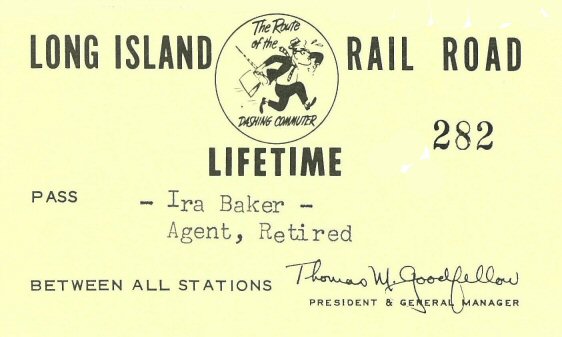
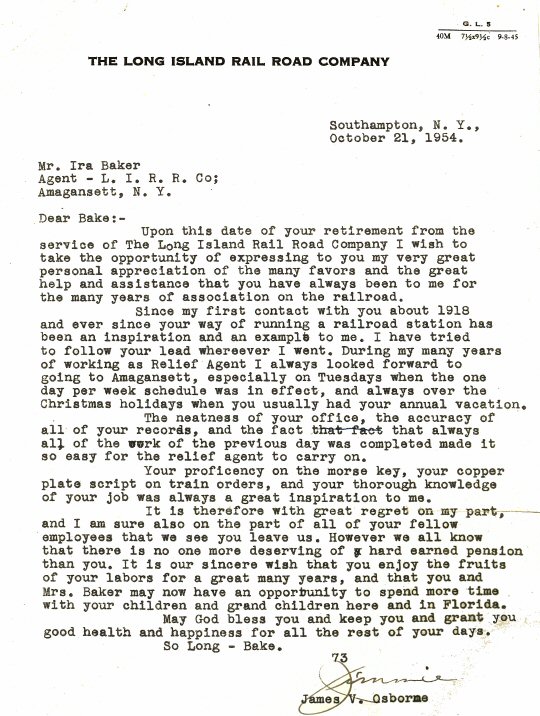
Ira's granddaughter told me
that she remembers visiting her grandparents while they resided upstairs
in the depot and that the kitchen was trackside.
She also mentioned that the Baker's shortly after Ira's retirement
moved to West Palm Beach, FL. Anne
Vaughn Baker died there in 1956 and Ira followed her in 1961.
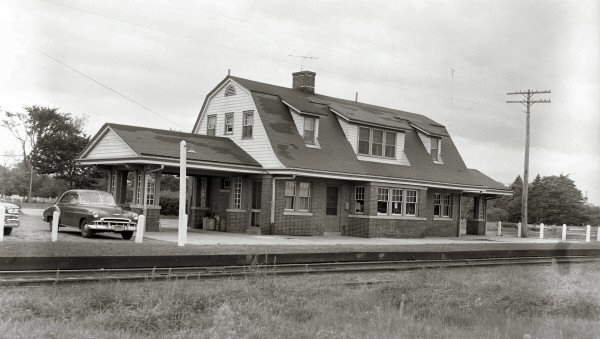
This
image of the depot building was taken in September, 1958 by LIRR trainman
Irving Solomon for the Public Service Commission when the LIRR was
planning on closing the agency which occurred by year's end.
The beautiful depot building, now showing wear at the roof, was
torn down on August 31, 1964 and replaced by a tiny wooden shelter shed.
(Dave Keller archive)
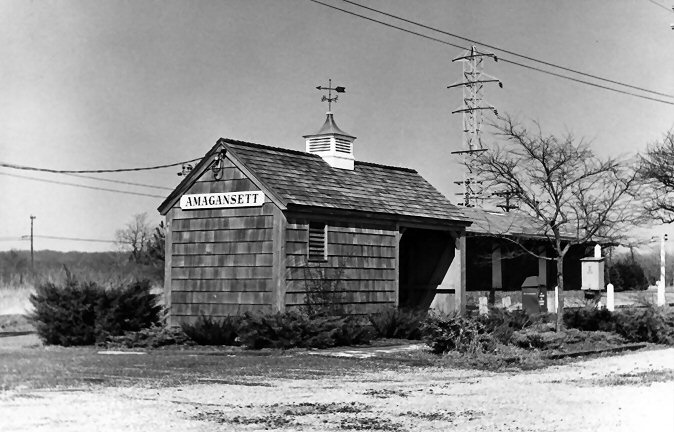
The
Amagansett station shelter shed, rear view looking northeast towards the
original, 1895, brick freight house. This
shelter still stands as of this biography with high level platforms added
just west of the structure. (Dave Keller photo and archive)